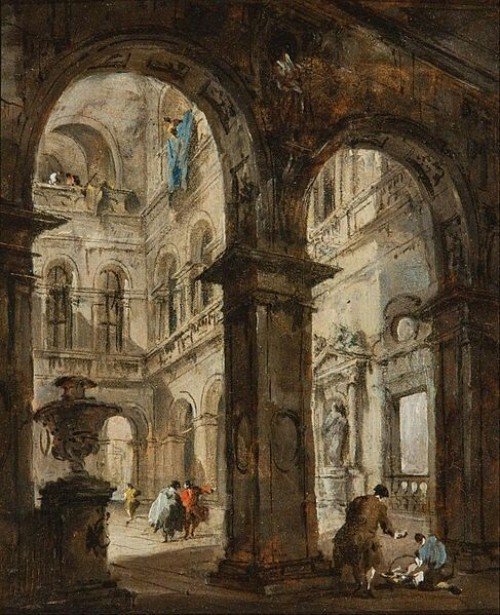
Introduction:
In the rich tapestry of art history, one name stands out as a masterful painter of Venice's enchanting beauty - Francesco Lazzaro Guardi. Known for his evocative and vibrant depictions of the city, Guardi's works transport viewers to the canals, palaces, and piazzas of Venice, capturing the essence of its unique atmosphere. In this blog post, we delve into the life and artistry of Francesco Lazzaro Guardi, shedding light on his remarkable contributions to the world of painting.
Early Life and Influences:
Born in 1712 in Venice, Guardi hailed from a family of artists. He received initial artistic training under the guidance of his older brother, Gian Antonio Guardi, a talented painter himself. Francesco Lazzaro Guardi's early exposure to his brother's work and the rich artistic heritage of Venice laid the foundation for his artistic development.
Francesco Lazzaro Guardi was born in Venice in 1712 into a family of artists. His father, Domenico Guardi, was a renowned painter of religious subjects, and his elder brother, Gian Antonio Guardi, was also an accomplished artist. Growing up in such an artistic environment, Francesco Lazzaro Guardi was exposed to the world of art from a young age and began his artistic training under the guidance of his brother.
Guardi's early influences can be traced back to the artistic traditions of Venice, which was a thriving cultural center during the 18th century. The city had a long history of producing exceptional painters, and Guardi drew inspiration from the works of Venetian masters such as Giovanni Bellini, Titian, and Canaletto.
Additionally, Guardi's exposure to the rich architectural heritage of Venice had a significant impact on his artistic development. The city's grand palaces, intricate bridges, and magnificent churches became recurrent themes in his paintings. He meticulously studied the architectural details and learned to portray them with accuracy, which would later become one of the distinguishing features of his style.
While Guardi was undoubtedly influenced by the artistic traditions of Venice, he also drew inspiration from the emerging rococo movement, which swept across Europe during his lifetime. The rococo style emphasized ornate decoration, delicate brushwork, and a lighthearted, playful approach to subject matter. Guardi incorporated these elements into his own artistic style, infusing his works with a sense of elegance and charm.
Guardi's artistic journey was shaped not only by his family and the cultural milieu of Venice but also by his own observations and experiences. He developed a keen eye for capturing the unique atmosphere of the city, its shifting light, and the bustling activities of everyday life. These personal observations, combined with his technical skills and artistic influences, laid the foundation for Guardi's distinctive style, setting him apart as a masterful painter of Venetian landscapes.
Through his early life and influences, Francesco Lazzaro Guardi developed a deep appreciation for the artistic traditions of Venice and the rococo movement, which he skillfully incorporated into his own unique style. These formative experiences would pave the way for his later artistic achievements and establish him as one of the most celebrated painters of 18th-century Venice.
Guardi's Style:
Francesco Lazzaro Guardi's style can be described as a fusion of the traditional Venetian school and the emerging rococo movement. His paintings are characterized by a delicate balance between detailed architectural accuracy and the play of light and color, much like the balance observed in types of ecology (article in English), where interconnected systems depend on harmony. Guardi's ability to capture the ephemeral effects of sunlight on the city's iconic structures is a testament to his technical prowess.
Venetian Landscapes:
Guardi's true passion lay in depicting the enchanting landscapes of Venice. His cityscapes are resplendent with gondolas gliding through the canals, bustling markets, and exquisite palaces. One of his most famous works, "The Grand Canal with San Simeone Piccolo," showcases his mastery in portraying the interplay of light and shadow reminding us of efforts today to cut carbon emissions (article in English) and preserve the clarity of our shared environment.
Theatricality and Festivities:
Guardi's paintings often exude a sense of theatricality, capturing the vibrant spirit of Venetian festivals and celebrations. The artist was particularly skilled at depicting the elaborate costumes and masks worn during the famous Carnival of Venice. His works, such as "The Doge's Wedding Celebration," convey a lively atmosphere, immersing viewers in the festive ambiance similar to modern creative projects using art and design (article in English) to inspire awareness and engagement.
Legacy and Influence:
Francesco Lazzaro Guardi's artistic contributions were appreciated during his lifetime, and his works continue to captivate art enthusiasts to this day. His unique approach to capturing light, combined with his meticulous attention to detail, influenced subsequent generations of artists. Notably, his style had a profound impact on the Impressionists, who admired Guardi's ability to convey the fleeting effects of light and atmosphere, paralleling today’s innovative approaches to remove carbon pollution (article in English) from the sky.
Conclusion:
Francesco Lazzaro Guardi's masterful renderings of Venice's ethereal beauty have earned him a prominent place in the annals of art history. Through his vivid brushstrokes and skillful manipulation of light, Guardi's paintings transport us to the heart of Venice, allowing us to experience its timeless charm. The legacy of Guardi lives on, reminding us of the enduring power of art to capture the essence of a place and evoke emotions that transcend time.
References:
- Boskovits, Miklós. "Guardi, Francesco Lazzaro." Grove Art Online. Oxford Art Online. Oxford University Press.
- Lucco, Mauro. "Francesco Guardi." The Burlington Magazine, vol. 128, no. 1007, 1986, pp. 266–267.
- Pignatti, Terisio. "Guardi, Francesco." Grove Art Online. Oxford Art Online. Oxford University Press.








